I’ve been a plant pathologist for 26 years, working in developing countries, originally studying diseases of bamboo, clove, woody legumes, and neem. In the last ten years the hosts and diseases that have concerned me have broadened to include many major crops. The hosts and diseases may change but one persistent question remains: How can plant pathologists best help poor farmers? Is it helpful, for example, to consider the need for fundamental and applied research separately, a distinction commonly made by scientists?
George Porter, a British scientist and Nobel laureate, made a simpler distinction: there was applied and “not yet” applied research. I like this approach since it emphasizes the need to find answers to problems. Robert May, past head of the British Office of Science and Technology, once said that scientists were good at asking questions, suggesting that research is not going to find answers easily. To help poor farmers manage their plant diseases better we need to find new ways of putting theory into practice.
That is the simple idea behind the Global Plant Clinic (GPC). In this article I want to show how an informal, multi-national network of colleagues (mostly but not exclusively plant pathologists), created and encouraged by the GPC, is attempting to use scientific knowledge and skills to help farmers in developing countries. This is an ambitious aim and one that a small network cannot do on its own. To make the task more difficult, we learned quickly that responding to plant diseases was not enough. Farmer demand is not readily defined by scientific discipline. For most growers it is symptoms that define problems and not causes, many of which are invisible, such as viruses. Growers have one question: “What do I do?” The GPC’s job is to find the best way of answering this question for as many farmers as possible.
| |
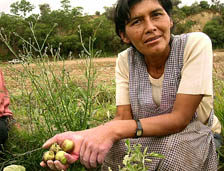
Fig. 1. Doña Felicia of Pulquina Arriba, near Comarapa in Bolivia, holds tomatoes with virus-like symptoms. She hasn't seen these symptoms before. |
However, it became clear that gauging farmers’ demands is a complex task in developing countries, as illustrated by a study in Bolivia (7). The researchers note the importance of implicit demands (those not expressed at first). An example from my own experience was when staff from CIAT Santa Cruz in Bolivia used a rapid diagnostic test for Tobacco mosaic virus, developed by the Central Science Laboratory, on tomato plants with unusual virus-like symptoms. The result was negative. The farmer never “demanded” this particular test, yet it provided useful information quickly on deciding what the farmer should do about the problem (the explicit demand). Highlighting implicit demands in plant health emphasises the role that molecular plant pathology, for example, can play in helping poor farmers.
History of the Global Plant Clinic (GPC)
First, some background to the GPC and its origins. The 1970s and 1980s saw a gradual rise in agricultural projects in developing countries. This was a time when many gained their independence and the previous colonial agriculturists, a proud and notable scientific heritage paid for by the United Kingdom, were becoming “technical cooperation officers.” The colonial service provided many of the early records of plant diseases in the tropics, as noted by Ainsworth (1). There was also a notable tradition of research by scientists based in the UK, travelling overseas. The new cadre of post-independence agriculturists made valuable contributions to important diseases such as lethal yellowing of palm in Jamaica (12), Cocoa swollen shoot virus in West Africa [e.g., (10)], and the less well known but equally damaging Sumatra disease of cloves in Indonesia (3).
| |

Fig. 2. Host records of Colletotrichum lindemuthianum. Handwritten for many years, the records include material received at the IMI Herbarium over the last 90 or so years. |
|
Such projects often continued for many years. The clove project in Indonesia began in the mid-1970s and did not end until 1990. But the vogue for big disease projects began to wane, partly because those who funded them (governments and multilateral organisations under the United Nations, World Bank, and similar) began to ask the same question: Is this science doing any good? The unstated accusation was that researchers were “capacity driven” and, as Robert May said, were “good at asking questions.” Donors wanted answers and practical methods that solved real problems, such as: How do you stop all these coconut palms from dying?
A plant pathologist will rightly say that this is an unfair question and that answers are not easy to find. It is less easy, however, to explain why huge rural development projects failed to deliver, and though plant diseases were a small component at best, the tarnished reputation of such projects has fed notions that development doesn’t work. That is the pessimistic view of William Easterly in a recently published book (The White Man’s Burden) while Jeffery Sachs (The End of Poverty) takes a more positive view. Paul Collier, an economics professor at Oxford University appears to fall between gloom and glory with his 2007 book The Bottom Billion.
Does development work? In a nutshell, Sachs says “yes,” Easterly “no,” and Collier says “sometimes.” My own view is that development does work, based on our experience of plant health clinics, which are at the centre of what the GPC does. Plant health clinics offer new avenues for applying the results of plant pathology research and for those results to make a positive contribution to farm family livelihoods. We are, however, still at an early stage of establishing clinics and more data is needed to assess their long term impact. It is also important to state that plant health clinics alone cannot overcome the many challenges of providing good advice to all farmers.
Plant clinics are nothing new, but they don’t always perform the same functions. The GPC grew out of a “diagnostic and advisory service,” a unique facility that became a distinct part of the Commonwealth Mycological Institute (CMI) in the 1980s under the fine leadership of Dr. Jim Waller. The GPC name and identity is more recent and has only become well established since around 2000. The GPC is managed by CABI. CMI became the International Mycological Institute before being absorbed into CABI Bioscience. The early history of IMI is described by Aitchison and Hawksworth (2). The Bioscience label has been dropped and now scientific and publishing activities are grouped under the single identity of CABI.
In the 1990s the diagnostic and advisory service expanded to include phytoplasmas and viruses under Prof. Phil Jones at Rothamsted Research. The virus identifications are now done at the Central Science Laboratory (CSL). In 2001, Rothamsted Research was funded under a single grant to CABI. CSL was formally included in the three way GPC alliance in 2005.
| |
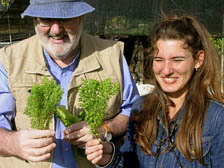
Fig. 3. Prof. Philip Jones of Rothamsted Research and Dr. Yaima Arocha of CENSA, Cuba share a curious delight in finding a confirmed phytoplasma disease on basil in a Havana organopónico. |
|
GPC Operations
A similar pattern of work was maintained for many years under the diagnostic and advisory service. People sent us samples from overseas and we would isolate fungi, bacteria, and so on and try to determine the cause of the problem. The number of samples stayed more or less the same and the people who sent them were regular users. We sent back information about control gleaned from CABI abstracts and from the Crop Protection Compendium. The information provided was often quite general, more a list of possible control options rather than specific advice. The information needed interpretation and local iteration to make it useful to farmers.
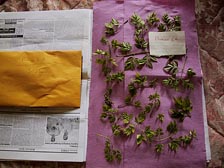
Fig. 4. How to send samples of Melia yellows, a phytoplasma disease, collected in Cochabamba in Bolivia.
|
|
As email became more widely available, people sent us photos. This was sometimes less useful than a sender had planned. When we received clear photos with unequivocal symptoms it was often easy to diagnose the problem (though we still received a major part of a tea plant covered with Phellinus noxius from Sri Lanka after identifying it from a photo). More tricky to diagnose were the blurred, poorly composed photos (of which there are rather too many), often of dead rather than dying plants, or simply showing equivocal symptoms. We often request samples, though these too are of variable quality. The heart sinks as you unwrap dried up and dead material. Equally disappointing are the plant samples that someone has collected and dispatched … in a plastic bag. There’s not much you can do with a festering mess of plant sample.
These problems aside, scientists plus a small group of users from commercial companies regularly sent us samples. Drawn from over 60 countries, users were pleased that someone could help them. Finding a laboratory that could help and receive samples from overseas was and remains a major challenge for many potential users. Once the samples had arrived there was an expectation that a result would quickly follow. We explained that a diagnosis might take weeks rather than days because the quality of samples varied (a much neglected reason) and because of the challenges of dealing with a wide variety of crops and diseases (you try it!).
I mentioned early that plant clinics perform different functions. Some are simply diagnostic laboratories and do not make recommendations. The US is one of the few countries I know where extension and research are regularly integrated around a clinic (e.g. North Carolina State University). A more common model is to have a ‘clinic’ staffed by experts in different types of pathogens (rarely all groups) often with little or no knowledge of growing crops. It would be more accurate to call them diagnostic laboratories. It highlights a lack of clarity and distinction between identification of pest organisms, diagnosis and advice. (Not so in human health, where pathologists analyse and offer a diagnosis but cannot, at least in the UK, treat patients — even then it is confusing, since pathology labs include clinicians who are also scientists and can treat patients.) When the diagnostic and advisory service was part of IMI the institute was best known for its taxonomic expertise in mycology. There was an uneasy relationship with plant pathology which only improved when CABI Bioscience was created. As the development focus became stronger so it became easier to develop a more integrated US-style clinic, as we now have with the GPC.
Advisory work is usually associated more with extension than research. Extension and research co-exist well in the US but in many countries and among many scientists it would be fair to say that advisory work has an image problem. It appears less glamorous compared to research, with a suggestion that it requires less effort. That was the impression I had when doing my Ph.D in an Agricultural Sciences Department at Leeds University. Now I see advisory work as a highly skilled job and have deep admiration for those who do it well.
At CABI, we wanted to know what happened to the advice we gave, but despite repeated efforts we rarely received feedback. At first I thought this was because of poor correspondents, but later the same people happily adopted email, suggesting that the real reason for poor feedback was weak contact with farmers. Under the diagnostic and advisory service it was scientists who were sending the samples to us, not the extension agents and agronomists who work regularly with farmers. These were the two groups that needed better access to our service. We needed to improve the way we worked.
| |
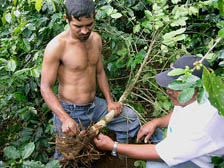
Fig. 5. Marvin Isidro digs up a sick coffee plant at the request of the plant doctors from nearby Jalapa in Nicaragua. They explain the importance of examining roots for swellings (possible nematod attack) and well-defined internal staining (possible fungal attack). |
|
Changing the GPC: Plant Health Service Initiatives
The pressures to change the diagnostic and advisory service were gradual but persistent. The major impetus eventually came because our funders, the UK Department for International Development (DFID), changed. The customer, in this case DFID, knows best.
The nearest equivalent to DFID in the United States is USAID. Both pursue similar aims. The change that ultimately shaped the GPC of today began with the election of the Labour party in 1997, led by Tony Blair. The new government announced an increased importance and seriousness about international development. Previous governments had been enthusiastic about international development but never, to my mind, very serious about it. Then DFID published a white paper with a stark title: Eliminating World Poverty. It announced a radical change of policy, one matched by increased funds to support a much wider range of activities.
This created some unease amongst scientists who read the white paper and found little overt mention of science. Up until 1997 there had been a sizeable chunk of UK government money for agriculture research and hence plant pathology. This shrank as health and education, for example, took on greater importance. Further impetus for change came in 2000 when the millennium development goals were published and strongly supported by the UK government. The millennium development goals set targets for improvements to be met after 15 years.
The diagnostic and advisory service continued its work at CABI while the policy debate about international development flourished, but already we were re-thinking what we should do next. The GPC identity started to emerge. A review in 2000 praised what we were doing, yet standing still was not a sensible option given the new thinking and importance of international development in the UK and elsewhere. I found the policy changes at DFID enlivening and it helped me rethink priorities. The most significant change was when we started to run plant health clinics. At first we weren’t quite sure what these should be, but six years of testing and observing different approaches has helped to mould a model for plant healthcare that is proving attractive to many people.
Collaborations with colleagues Mick Blowfield, Paul Van Mele and, most importantly, Jeffery Bentley, an agricultural anthropologist, helped me learn more about farmers and agriculture, and to see the implications for the GPC. The truth was that I didn’t know much about either farmers and agriculture, despite having lived in Bangladesh and Indonesia for ten years. The resistance to making more use of social scientists in agriculture (usually by natural scientists) never made sense to me. The posturing and (unspoken) interchange of brickbats – “you don’t know anything about plant diseases” (pathologist to anthropologist) and “you ignore what farmers need” (vice versa) – is unhelpful, though thankfully has disappeared over time. A good medical doctor is someone with good social and clinical skills. The same applies to plant doctors.
| |
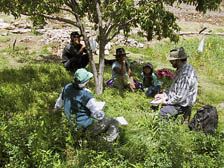
Fig. 6. Daniel Vasquez (front left) interviews a peach farmer in Sucre, Bolivia about the health of her trees. Jeff Bentley (right) takes notes. |
|
The main effect of learning more about farmers and agriculture was to work closer with extension agents, giving rise to a new extension method called Going Public [(6), Research 4 Development, and Agriculture 21]. Other innovations include a method for writing fact sheets on plant diseases (and other topics) which are peer-reviewed by farmers, and a new method for self-evaluation of technology projects. The GPC still does research on specific plant diseases, though it is limited to major problems supported by additional projects. Examples include Napier grass stunt at Rothamsted Research, and banana xanthomonas wilt at CABI and more recently CSL.
The GPC works in developing countries in Africa, Latin America, and Asia. We now spend about 60% of our time collaborating, encouraging and training colleagues in key countries. Uganda, Bangladesh, and Bolivia were the first three countries where we set up “plant health services initiatives.” The centre of these initiatives is the plant health clinic (originally called mobile plant clinics, a phrase still in use), a new focal point for receiving farmer demands and meeting them.
The GPC continues to provide an expert laboratory diagnostic service for all diseases on all crops, but access to the service is difficult for many in developing countries, even though plant health clinics have improved the sending of samples from growers, particularly poor ones. The cost of sending samples, plus getting permits and other bureaucratic barriers adds to persistent difficulties in collecting suitable material (paying for fuel is a frequent problem). We continue to work on improving access, particularly by making better use of national laboratories. But we have also taken a new approach to better diagnosis by training people in field diagnosis. This is where causes are deduced from symptoms and other information obtained from the growers and direct observations.
Field diagnosis is the most common method for determining the cause of a plant health problem. It works surprisingly well in many cases though there is little if any formal training on how to do a “field diagnosis.” When the GPC began to support plant health clinics in Bolivia and Bangladesh, we saw that the agronomists who ran them were good at diagnosing common diseases and pests but they struggled when people brought crops they were unfamiliar with or presented vague symptoms. Plant doctors have to deal with all types of problems and it was this realisation that prompted the GPC to provide training in field diagnosis.
The early emphasis on field diagnosis training was questioned by many plant doctors. They wanted more training in “control.” Later we saw the need to produce extension materials. A curriculum for training plant doctors has been steadily developed over the last decade and now consists of three modules (training courses), each lasting 2 to 3 days. The first module shows how to do a field diagnosis and run a plant health clinic. (The aim is to get clinics running as quickly as possible. Learn on the job.) The second module looks at plant “healthcare,” a term I deliberately use to make further analogies with human health, and which includes crop protection and IPM technologies. The third module is on preparing extension messages (mainly writing fact sheets) and how to deliver them to farmers.
A key lesson from the first training courses in Uganda and Kenya, was to separate recognition of symptoms from their interpretation (the diagnosis). People were eager to label a rot as “fusarium” or a leaf spot as “anthracnose”, perhaps because it sounded more scientific and decisive. It suggested that distinct symptoms were present where on closer examination there was often room for doubt – and a lack of supporting evidence from laboratory analyses.
| |
Fig. 7. Edwin García of UNAG helps to run the Puesto para Plantas in San Juan del Río Coco in northwest Nicaragua. He's comparing possible anthracnose on coffee with similar symptoms on yam from the CABI Crop Protection Compendium. The two diseases are caused by the same fungus but there's no picture of coffee anthracnose available. Comparing symptoms with photographs is a common way of diagnosing problems. It's clumsy and prone to inaccuracy, but it may be the only way available to plant doctors in remote regions. |
|
The first training module in “how to become a plant doctor” uses group exercises to compare what people see on sick plants before offering an “expert” opinion on a sample. This is a standard teaching method we use: people first do a simple exercise, then compare results between themselves before the teacher offers “expert” advice. Courses are attended by extensionists, scientists and farmers and confidence is often shaky at first, hence the need to begin gently and avoid emphasising what people don’t know or get wrong. The interpretation (diagnosis) of symptoms begins with a simple distinction between biotic and abiotic before proceeding to particular causes. We include arthropod pests as well as all major pathogens and non-pest causes. One of the key messages is that a field diagnosis proceeds by elimination and that it is usually easier to say what is not causing symptoms before suggesting a likely cause.
In the Beginning: Bolivia
Jeffery Bentley and myself first started talking about plant health clinics in Bolivia in the late 1990s, when we were starting to explore local knowledge of plant health problems (9). The idea was to hold clinics in markets, where people could “walk-in” without prior appointment. In 2001 we began a short project to promote practical tests to help growers diagnose plant health problems. One of the tests was to detect potato nematode cysts in soil: curl a sheet of newspaper inside a drinking glass, add soil, then water, and swirl. Cysts adhere to the paper and are visible to the naked eye when the paper is withdrawn.
We discussed the test with Juan Almanza, an expert técnico (extension agent) who works for PROINPA, and the possibility of doing a public demonstration. Jeff and I were staying at PROINPA’s experimental station in Toralapa and the next day (Friday) there was a weekly market at nearby Tiraque. In one of those inspired moments, Juan suggesting doing the demonstration in the back of the pickup in the market. The event is described in Bentley et al. (5) and has given rise to a new extension method called “Going Public.”
| |
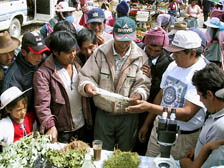
Fig. 8. Juan Almanza of PROINPA is skilled at holding the attention of a shifting crowd in the weekly market at Tiraque in Bolivia. He demonstrates a quick test that shows if soil is infected with nematode cysts This was the first ever Going Public event and a precursor of plant health clinics everywhere. |
Tiraque market was my first experience of improvising an extension exercise on plant health. Juan began his demonstration and repeated it several times over three hours for new audiences as people moved on and others took their place. Jeff an I witnessed an “unfolding conversation” (4), with Juan patiently answering questions about the test and the cysts (he had a microscope to reveal the contents and got people to draw what they saw). Juan did this all with great skill and in a natural way that astounded me. Until then, I thought that extension had to be planned, with farmer meetings and fields days, training and demonstration events. Juan’s performance was an amazing demonstration of how good extension agents can be. It was very rewarding to observe, though perhaps not something everybody is willing or able to do. Outsiders are good at suggesting new things for others to do but often they need permission first.
Around the same time as the Tiraque event, a community plant health clinic (LADIPLANTAS) was established by CIAT Santa Cruz in Comarapa, Bolivia (7). This arose from another project (MIP-PAPA) on integrated pest management of potato pests and diseases. LADIPLANTAS is located in offices in the town and is open most days of the week. Farmers can bring in samples or have them collected in the field by técnicos working for CIAT and other organisations.
I then requested Jeff to hold a short workshop on behalf of the Global Plant Clinic with the aim of starting a plant health clinic in Tiraque (5). The first ever Posta para Plantas began in September 2003 and has been held regularly since, faithfully attended by Ing. René Pereira and staff from Toralapa. From the beginning we emphasised the similarity between clinics for plants and those for people (Posta de Salud): to offer advice on (plant) health problems.
With support from the GPC and Javier Franco at PROINPA, the Tiraque clinic has continued. Over 400 people presented queries in the first year. The early publicity for the clinic concentrated on telling researchers and extension workers about their popularity and new ways of interacting with farmers. PROINPA now run clinics in El Puente, Colomí, Punata, and Tiraque, a good example of how a successful clinic well publicised encourages other clinics to start.
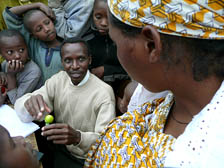
Fig. 9. Ntozi works for ISAR, the Rwandan agricultural research organisation, and is asking about a problem that affects this lady’s crops during a pilot plant clinic run in the market place in Miheto, near Ruhengeri. |
|
A striking difference between running a clinic and doing plant pathology research is the variety of problems you have to deal with. I always imagined that clinics would be run by extensionists and agronomists, people familiar with local agriculture and already known to many farmers. Others have suggested that clinics should be staffed by plant pathologists with expert knowledge in all disease causes. Extensionists make good doctors, at ease with farmers. The best ones have the confidence to admit they don’t know something but they will find out more. Scientists also make good plant doctors, though attending a clinic each week is difficult. Others are uneasy about diagnosing from symptoms and giving advice on the spot. They are reminded that this is what medical doctors do all the time.
When clinics start the plant doctors soon realise the challenge of giving advice. They are not used to a farmer who returns to say that ‘your advice did not work’ or to ask ‘what is the name of the resistant variety and where do I buy it’. Plant doctors are encourage to say when they don’t know – and that they will try to find an answer. The best advice is often not to do something. For example, a plant doctor can advise to not use an insecticide because she has diagnosed a fungus disease. Feedback from farmers and regular monitoring of clinics helps to improve diagnoses and the quality of advice.
After Bolivia, we turned our attention to Bangladesh and Uganda, two countries where CABI and the GPC already had good contacts. As of October 2007 there are eight countries with over 60 clinics running regularly (Table 1). We have run pilot clinics in other countries, such as Colombia, Benin and Cuba though none have become regular. The biggest clinic scheme is Nicaragua, and that is what I will now discuss in more detail.
Table 1. Plant health clinics around the world.
| Country |
No. |
Started |
Managed by |
| Bangladesh |
25 |
2004 |
RDA Bogra, AAS, and Shushilan |
| Bolivia |
7 |
early 2004 |
CIAT Santa Cruz, PROINPA, and UMSS |
| DR Congo |
8 |
March 2006 |
Université Catholique du Graben, Butembo |
| India |
2 |
August 2006 |
GB Pant University of Agriculture and Technology |
| Indonesia |
2 |
October 2007 |
University of North Sumatera (USU) |
| Nicaragua |
14 |
March 2005 |
Farmer organisations, NGOs, INTA, and others. Supported by PASA II (danida) and other donors. |
| Uganda |
4 |
July 2006 |
Socadido, SG2000, Caritas and MAAIF |
| Vietnam |
2 |
June 2007 |
SOFRI |
Puestos para Plantas: Nicaragua
In 2004 Dr. Solveig Danielsen took up a post in Nicaragua, as an advisor to FUNICA, an organisation created to manage technology projects and provide a missing link between government institutes and the private or informal sector, where non-governmental organisations (NGOs) and farmer organisations operate. Soon after arriving, it became clear that a lack of reliable and regular services was hampering progress. Solveig knew about the plant health clinics in Bolivia and suggested that the GPC be invited to try them out in Nicaragua.
In March 2005 I went with Dr. Jeffery Bentley to test clinics in Las Segovias. It was a tough assignment since none of us had a clear idea of who was going to run the clinics. We had useful leads and the strong support of PROMIPAC, a donor-funded project on integrated pest management which was run by Zamorano University. Julio López played a vital part in creating openings for the clinics and has been an invaluable colleague in supporting their expansion and growing influence.
Our first two attempts to get clinics started were only partly successful. We ran one pilot but it was unclear whether it would continue. Then we met Yamileth Calderón of UNICAM, a “campesino university.” Yami is an agronomist and knows local farmers and agriculture well. She is out-going and enthusiastic. She liked the sound of clinics and agreed to run one at very short notice.
On the 11 March 2005 the first ever Puesto para Plantas in Estelí took place, our second pilot clinic in Nicaragua. It was rudimentary — a table, some diseased plants, a microscope (which we didn’t use, and I’m not sure impressed any potential clients), a hand-written sign, and two enthusiastic plant doctors: Yamileth and María Rosa Herrera of ISNAYA. The stall (puesto) was placed at the end of a row of vendors who make up the weekly mercadito verde, an organic market for vegetables, fruits, and other products. We had 14 queries in under two hours, and we all felt pleased about the results. The users included people passing in the street and market traders that Yamileth knew.
| |
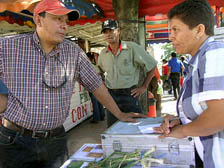
Fig. 10. Yamileth Calderón (right) is the plant doctor at the weekly Puesto in Estelí, Nicaragua. She was the first person to start a clinic and has been an inspiration to many others who have since started their own clinics. |
|
Jeff, Solveig, and myself were now much more optimistic that this Puesto would continue, and it has. The key to success, however, has been Yamileth. (I also want to mention the support of Edgar Castellón of UNICAM, who has allowed Yamileth to spend the time running the clinic. The employers of plant doctors make important contributions which need to be discussed and agreed from the outset.) Yamileth turns up each week at the same time, sometimes with colleagues or with students from UCATSE.
Two years on from the successful Puesto in Estelí there are 14 operating in Nicaragua. The Estelí Puesto was soon joined by new Puestos in El Jícaro, Jalapa, and San Juan del Río Coco. The GPC helped to spread news about the first Puestos, so that others might be inspired by the efforts of fellow Nicaraguans. We produced photosheets of the clinics and made a logo. Monthly meetings organised by FUNICA staff helped create a group identity with a shared purpose from an early stage.
Since 2005 Jeffery Bentley and I have jointly made seven visits with a final visit scheduled for late in 2007. During this time we have trained plant doctors and refined a curriculum on “how to become a plant doctor.” I want to stress, however, that the true expansion of the clinics and the emergence of a network of diagnostic laboratories (see later) and other initiatives have come from within Nicaragua. These events have been carefully nurtured by Solveig Danielsen, whose role in the successful development of the clinics has been vital (11).
Plant pathologists rarely reflect on human behaviour, yet looking back over an intensive period of activity around the Puestos, it has been the interaction between extension agents and farmers, and extension agents and researchers that has helped the Nicaraguan scheme achieve its momentum and expand from the original three clinics in mid-2005 towards a planned 33 clinics in 2008.
As the clinics gathered strength and became better known, Nicaraguan scientists saw the need for a network of diagnostic laboratories. Bringing together universities and official government bodies, the “red de diagnosticadores” is a Nicaraguan initiative, an encouraging sign of how the Puestos have prompted scientists to take action.
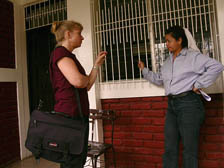
Fig. 11. Liliam Lezana (right) with Solveig Danielsen. Liliam is the coordinator of the “red de diagnosticadores” and one of a dedicated group of Nicaraguans who have worked hard to make the Puestos effective. |
|
Access to diagnostic laboratories (clinics) in many countries is difficult and this is particularly true for poor farmers. Their contact with extension is weak and sending samples for analysis is impossible. The arrival of the Puestos and the creation of the diagnostic laboratory network meant that poor farmers in Nicaragua could send samples for the first time. First we needed to figure out who was going to pay for the samples. The cost of a diagnosis is around US$6, a lot of money to a poor farmer. Donors have made funds available for now but in the future all or some of this money will have to be paid by users of the diagnostic service.
In 2007 we began training trainers and by the end of this year Nicaragua will begin its own programme for producing new plant doctors. Around 40 people have taken the three training modules that constitute the ‘how to become a plant doctor’ course. Module 2 explains how to select the plant part and how to package it correctly. The quality of samples has improved, though it requires constant attention and dialogue between plant doctors and scientists.
The Puestos have strengthened links between groups of people who had few opportunities before to talk about shared interests in plant health problems: farmers who want answers, extension agents who want possible solutions, and scientists who can diagnose problems and develop new technologies. These three key groups – growers, extension staff, and researchers – have all benefited from Puestos, encouraging them to create a single vision of plant healthcare. A DVD has been produced on the Puestos para Plantas and copies of publications, factsheets, and more can be found on the FUNICA website.
Pesticide use dominates discussions about plant health in many countries and Nicaragua is no exception. Yet while no one disputes the need to reduce pesticide use and ensure the safe application in the right circumstances, a focus on pesticides has distracted attention from a much simpler issue (Science and Development Network). How do you advise growers on the best method for managing their plant health problems? The Puestos are a new way of tackling this persistent question and providing a platform for promoting IPM technologies.
The ultimate goal is to establish plant health services for farmers that are available year-round. We want plant clinics to operate in more areas and to do so each week. We want laboratories to respond quickly and decisively when they receive samples, helping plant doctors give advice that is “safe, sound, and suitable.” We want the government of Nicaragua to recognize that a new support system for farmers has emerged in response to local demand and local initiative. What began as a tentative pilot scheme in 2005 has become a de facto system of plant healthcare serving the needs of hundreds of poor farmers. For that system to continue it needs official recognition and incorporation into government policy. This is what we will be discussing in late 2007 when all major groups with an interest in plant health will be represented.
The Future of Plant Health Clinics
From 2005-2006 nine Puestos received 1175 queries from more than 700 users. Since over half of the Puestos were not in operation until late 2005, that is an impressive measure of the demand for services. As more Puestos start to operate, and existing ones improve their current operations, demand will increase. An essential part of running a Puesto is to maintain a register of users, their queries and the outcomes. This is essential information when explaining why national and local governments should invest in the Puestos. Donor funds will eventually end and we need to discuss other sources of financial support and how much growers should pay for the service. We argue that Puestos are a public service, and like hospitals and schools, have public benefits. The challenge is to convince elected officials and for them to commit funds that keep the Puestos going once donor funds are no longer available.
We are optimistic this will happen, if only because the numbers who have used the clinics are clear evidence of their value. At the same time, we also need to strengthen ties between the weekly clinics and the regular work carried out by extension agents, so that we know more about how recommendations made by the plant doctors help growers. Nicaragua has provided inspiration to other countries that have plant clinics. With India planning to introduce clinics in all 40 states, the stage is set for providing poor farmers with better advice that helps them grow healthy crops with reduced risk and lower costs.
Acknowledgments
The work I have described is the result of many peoples’ efforts, including colleagues in Bolivia, Bangladesh, and Uganda. I thank them all for their contributions. I particularly want to acknowledge ideas, inspirations, and stimulating discussions with Jeffery Bentley and Solveig Danielsen and fellow GPC staff at CABI, Rob Reeder and Paula Kelly, and the support of Julie Flood and John Lucas. Julian Smith, Rick Mumford, Val Harju, and Wendy Monger at CSL and Yaima Arocha at Rothamsted have provided excellent diagnostic services while Phil Jones, now retired, has been an invaluable colleague for many years. I’d also like to thank Jim Waller and Tom Preece, two mentors who have encouraged me for many years and gave me ideas that are now blossoming thanks to a growing band of people around the world. Healthy plants for healthy people!
Literature Cited
1. Ainsworth, G. C. 1981. Introduction to the History of Plant Pathology. Cambridge Univ. Press, Cambridge, UK.
2. Aitchison, E. M., and Hawksworth, D. L. 1993. IMI: Retrospect and Prospect. A Celebration of the Achievements of the International Mycological Institute 1920-1992. CAB Int., Wallingford, UK.
3. Bennett, C. P. A., Hunt, P., and Asman, A. 1985. Association of a xylem-limited bacterium with Sumatra disease of cloves in Indonesia. Plant Pathol. 34:487-494
4. Bentley, J., Velasco, C., Rodríguez, F., Oros, R., Botello, R., Webb, M., Devaux, A., and Thiele, G. 2007. Unspoken demands for farm technology. Int. J. Agric. Sust. 5:70-84
5. Bentley, J. W. 2003. Starting a Plant Health Clinic in the Organized Chaos of a Bolivian Farm Fair. Global Plant Clinic, CABI. (Available from: e.boa@cabi.org).
6. Bentley, J. W., Boa, E., Van Mele, P., Almanza, J., Vasquez, D., and Eguino, S. 2003. Going Public: A New Extension Method. Int. J. Agric. Sust. 1:108-123.
7. Bentley, J. W., and Boa, E. R. 2004. Community Plant Health Clinic: An Original Concept for Agriculture and Farm Families. Online. Global Plant Clinic, CABI, Wallingford, UK.
8. Bentley, J. W., Thiele, G., Oros, R., and Velasco, C. 2004. Cinderella's slipper: SONDEO surveys and technology fairs for gauging demand. Online. Network Paper No. 138, Agric. Res. & Ext. Network, Overseas Development Institute (ODI AgREN), London, UK.
9. Boa, E. R., Bentley, J. W., and Stonehouse, J. 2001. Standing on all three legs: The técnico as a cross-cultural occupational group. Econ. Bot. 55:363-369.
10. Brunt, A. A., and Kenten, R. H. 1971. Viruses infecting cacao. Rev. Plant Pathol. 50:591-602.
11. Danielsen, S., Boa, E., and Bentley, J. 2006. Puestos para Plantas in Nicaragua. Online. Global Plant Clinic, CABI, Wallingford, UK.
12. Harrison, N. A., and Jones, P. 2004. Lethal yellowing. Pages 39-41 in: Compendium of Ornamental Palm Diseases and Disorders. M. L. Elliott, T. K. Broschat, J. Y. Uchida, and G. W. Simone, eds. American Phytopathological Society, St. Paul, MN.
Video Links
Available from Eric Boa's channel on YouTube.
| |
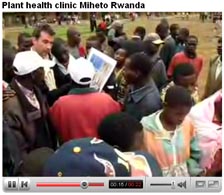 |
|
Plant health clinic Rwanda. The clinic has just started. It's late afternoon but around 90 people attend in less than two hours. 15 people present queries. |
|
| |
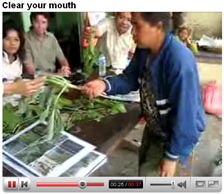 |
|
Samples for clinics. Plant clinic in Berastagi, North Sumatra. Delima and Rob Harling help a confused user obtain the right sample. |
|
| |
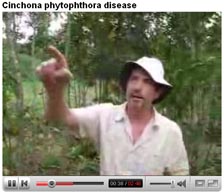 |
|
Remember to look inside plants. This impromptu video of internal staining is given by Fen Beed of IITA and is one way of explaining how to sample material for people who live a long way from clinics. The host is the fever tree or cinchona and the disease Phytophthora stripe canker. Location is near Butembo in North Kivu, DR Congo. Next time we'll use a proper knife (as recommended in the commentary). |
|
| |
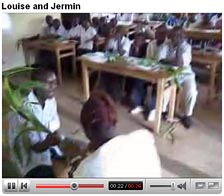 |
|
Training plant doctors. A short exercise, part of training course module 1, to develop interview techniques for plant doctors. Taken on a 2007 course at the Université Catholique du Graben in Butembo, North Kivu, DR Congo. |
|
| |
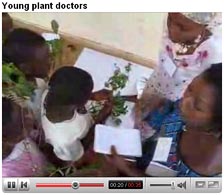 |
|
Young plant doctors. Schoolchildren in Butembo describe symptoms on plants with the help of Ange, who has just completed module 1 of 'how to become a plant doctor'. The suggestion is that schools run mini-clinics once a week. Every family in Butmebo, N Kivu, DR Congo. has a garden and grows crops. |
